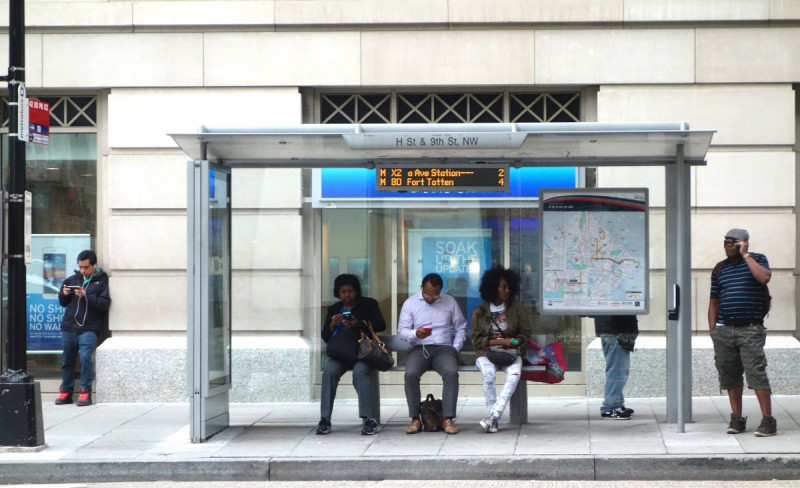What’s it really like to ride the bus while Black?

Waiting on the bus in DC by nevermindtheend licensed under Creative Commons.
Black people are disproportionately represented in the essential workforce and rely on public transit at a greater rate than other demographic groups. But, disparities in access to quality healthcare, paid family leave, and telecommuting have allowed COVID-19 to ravage these communities at a greater rate, while also placing a great deal of stress on the public bus system.
Recently, Greater Greater Washington hosted “Riding While Black,” a panel discussion, made possible by TransitCenter, which focused on making the bus better for every rider. We centered our talk on three key questions:
- Historically, how has transportation been used to advance systemic racism?
- What has COVID-19 revealed about the ties between the Black community and bus transit?
- What are the meaningful changes that leaders in transportation need to take to advance racial equity?
The panel included: Veronica Davis, Co-owner and Principal of Nspiregreen, Jerome Horne, Rider Experience Specialist at IndyGo, Kyle Reeder, co-lead of the Prince George’s County Bike and Pedestrian Advisory Committee, and Bill Washburn, a former transit planner with the District of Columbia Office of Planning and Prince George’s County Planning Department.
You can watch the full panel discussion below, and check out some key takeaways from our conversation.
Historically, how has transportation been used to advance systemic racism?
The infrastructure which moves the nation has long been used to divide people. “Basically, transportation systems were used to define communities,” Bill Washburn said. “When we started dealing with the highways and railroads it was to cut communities off from other parts of the city.”
In many cases, this meant the breakup or removal of Black people from land that was significantly undervalued in comparison thanks to practices like redlining. Veronica Davis shared that her grandparents’ home in Baton Rouge was seized in order to make way for the construction of Interstate-10.
But the ties between systemic racism and segregation go back further than the creation of the Interstate Highway System. The doctrine of separate but equal, a cornerstone of the Jim Crow regime, was affirmed by the Supreme Court in Plessy v. Ferguson in 1896.
“Plessy versus Ferguson had to do with a brother trying to get a seat on a segregated streetcar in New Orleans,” Washburn said. Separate but equal would be the law of the land for nearly six decades, finally being overturned during the landmark Brown v. Board of Education decision, and finally killed with the Civil Rights Act of 1964.
To equitify our transportation policy means infusing our most marginalized committed into how we discuss, plan, implement policy. GGWash #ridingwhileblack happening now! #savetransit #transitequity pic.twitter.com/416VmS6iux
— Greater Greater Washington (@ggwash) August 11, 2020
What has COVID-19 revealed about the ties between the Black community and bus transit?
Jerome Horne shared that in Indianapolis bus ridership dropped by 50%, much lower than WMATA’s 70% drop in bus ridership. “Part of that is that by and large is that the majority of our ridership are those that are essential workers,” Horne said.
IndyGo adopted best practices used in other cities to keep riders safe like implementing rear-door boarding, sectioning off the area around bus operators, and reducing bus schedules down to Saturday levels of service. But these changes have come at a cost for transit agencies. “For a lot of systems around the country, there were situations where bus routes were cut and are still cut,” he added, “And it’s a question of whether or not those are going to be restored.”
On the other side of this, some municipalities, like Prince George’s County, have recognized the role of their bus systems in combating COVID. “Under County Executive Angela Alsobrooks and her Department of Public Works and Transportation have recognized the need of making sure that these systems, like The Bus system, are funded,” Kyle Reeder said. “Essential workers are still going to work” and Prince George’s has responded by increasing service in Inner Beltway communities, he added.
On the bus by Erin Reidy licensed under Creative Commons.
What are the meaningful changes that leaders in transportation need to take to advance racial equity?
The night ended with conversations about what needs to change to tackle systemic inequities. Funding plays a big role everyone said. “We need more funding for transit, and we do need to specifically earmark and allocate funding toward bus service,” said Horne.
Washburn added that federal funding for highways in comparison to other modalities has always been “lopsided.” But he added that funding alone won’t make transportation systems better for communities of color. “Transportation systems, whether it’s bus or train systems or whatever, these are not things that exist in a vacuum,” he said. “One thing that happens that turns a lot of Black people off is that the planning processes tend to be rushed and they tend to ‘x’ the community out.”
He cited Nashville’s transit expansion failure as an example, which TransitCenter said failed both because the city failed to reach out to the city’s African American community and the pace at which the campaign took place.
Davis added earlier that city’s must do better at delivering essential services before they introduce new concepts. “How do you talk about new infrastructure when people haven’t had their base needs or concerns met?” she asked. “I have a pothole in front of my house. How do I trust you to deliver this other thing on time?”
“What kind of communities do we want to live in?”
The conversation provided a peek behind the “Black cookout curtain,” and ended with a very important question from Washburn: “What kind of communities do we want to live in? No one is asking us that.” Conversations like last week’s provide insight into how Black people move, but more importantly how they want to move throughout them.
